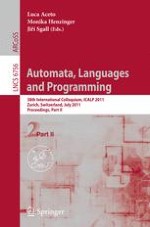The two-volume set LNCS 6755 and LNCS 6756 constitutes the refereed proceedings of the 38th International Colloquium on Automata, Languages and Programming, ICALP 2011, held in Zürich, Switzerland, in July 2011. The 114 revised full papers (68 papers for track A, 29 for track B, and 17 for track C) presented together with 4 invited talks, 3 best student papers, and 3 best papers were carefully reviewed and selected from a total of 398 submissions. The papers are grouped in three major tracks on algorithms, complexity and games; on logic, semantics, automata, and theory of programming; as well as on foundations of networked computation: models, algorithms and information management.
